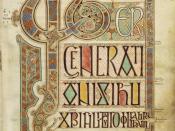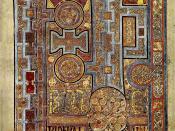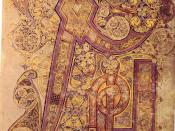Lion Symbol of Saint John, from the Book of Durrow: Page 334fol. 191v, c. 650-700. Illuminated manuscript on vellum; 9 2/3 x 5 3/4 in.
An early medieval manuscript from the second half of the seventh century.
Produced on vellum pages.
Uses only four colors to decorate: red, green, yellow and brown. These colors as well as the red dot pattern from the lion's face, are repeated in the border's interlace.
Celtic/Irish interlace paired with a Lion figure in a profile that implies power with it's bared teeth as if it were roaring.
This folio was used at the beginning of the section on Saint John.
Symmetry is present in the interlace border, each side mirroring the other.
Tunc Crucifixerant XPI, from the Book of Kells: Page 335fol. 124r, late 8th to 9th century. Illuminated manuscript on vellum; 9 1/2 x 13 in.
A late medieval manuscript from the late eighth to early ninth centuries.
High quality vellum pages were used, though of uneven thickness; ranging from thick as leather to so thin to almost be translucent.
The text uses a broad color palete: purple, lilac, red, pink, green, yellow being those most often used.
This folio is a page from the Gospel of Matthew (27:38).
The letter 'T' is very complex with an animalistic head for the curve of the 't' and the shelf of the 't' outstretches to legs on one end and arms on the other. A Dragon's head complete with flames is inserted into the border interlace to the left of the main 'T' from the text.
The border has numerous patterns, some that are unique and do not repeat.
People in profile have been inserted to the interlace as well.
The red dots are used for intricate designs surrounding the text.
The text...


